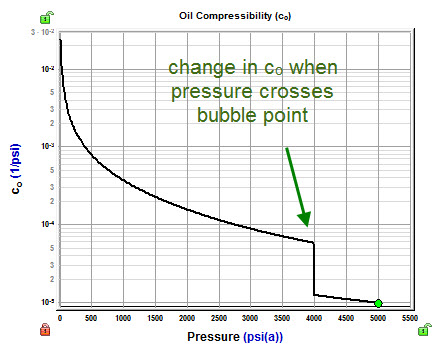Fluid properties (such as compressibility, viscosity etc.) depend on pressure; therefore, while a reservoir is being depleted, fluid properties change.
For gas analytical models, pseudo-pressure and pseudo-time are used to account for the change in gas properties.
For oil analytical models, fluid properties are assumed to be constant: properties are estimated at the initial pressure using correlations or tables set in the Properties editor, and these properties are used for calculations throughout the production history and the forecast.

This assumption is acceptable if the pressure in the reservoir remains above the bubble point, since the variations for under-saturated oil properties with pressure are negligible. However, if the pressure drops below the bubble point, oil properties (in particular – oil compressibility) change significantly.

As a result, numerical models are recommended for forecasting in under-saturated oil reservoirs, or for history matching in saturated oil reservoirs. However, analytical models can be used to history match a brief portion of data, such as a buildup, in saturated oil reservoirs because the properties aren’t changing significantly during the segment being analyzed. Although oil analytical models do not honor varying oil properties, it is possible to use (constant) oil properties corresponding to the depleted reservoir conditions.
Example: Consider an under-saturated oil reservoir with: pi= 5000 psi and pbp = 4500 psi.
The well was producing at a constant rate (drawdown) and then was shut in (buildup). During the drawdown, reservoir pressure dropped to 4,400 psi; therefore, during the buildup, the reservoir was filled with saturated oil. As a result, saturated oil properties should be used to history match the buildup.
To do this in an analytical model:
1. Select the PVT Pressure option in the Analytical Model pane.
2. Expand the PVT Pressure group and set ppropto 4,400 psi.

In this case, the properties used for calculations are evaluated at pprop.

Note: With this approach, the drawdown portion of the data is not matched. However, matching just the buildup portion of the data is useful, as it helps to estimate current reservoir and completion properties.